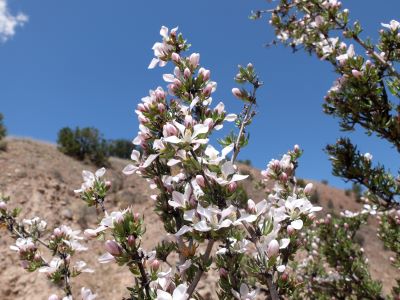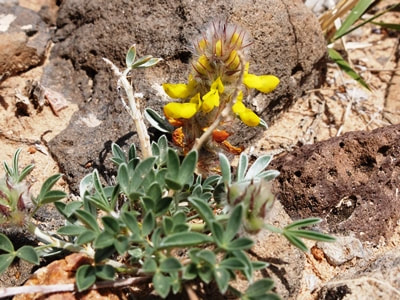|
Found in disturbed soil, roadsides
Seen blooming in May by Highway 84 These dandelion lookalikes are quite common in this area but easily missed because they only open when the sun shines on them, then close after a few hours; from 9am to 11am in my observations. Cutleaf Vipergrass grows to 20 inches tall on a grooved, hollow stem with milky sap. Leaves are narrowly divided and grass-like. The bright yellow flowers are almost one inch across and have long, brown-tipped bracts. Seed heads are also dandelion-like and two inches across. It also looks like a small salsify, hence another common name, False Salsify. Viper Grass is the European name for this plant, so called because the milky sap was believed to be useful to treat snakebites. Because of its recent introduction to North America there is no traditional Native American use for the plant but it is used in folk medicine in southern Europe and Asia in the therapy of arteriosclerosis, kidney disorders, wounds, rheumatism, and also in antidiabetic, antihypertensive, and antinociceptive medications. Source. If you are trying to identify a different flower then you can check what other flowers bloom this month. If you cannot identify a flower from the website, send a photo and where you took it to [email protected]. Read online for tips.
0 Comments
Found in sandy washes and canyons
Seen blooming in May on Espinosa Trail, Santa Fe NF Unlike the more familiar Showy Milkweed which grows 3 feet tall, Dwarf Milkweed grows sprawling on the ground up to 10 inches. Leaves are long and folded with woolly edges. Milkweed flowers are both beautiful and structurally complex. Dwarf Milkweed flowers are yellowish-white and produce fat, erect seed pods 1½ to 2½ inches long which split open to allow the large brown seeds with silky plumes to escape. Milkweeds contain various amounts of poisonous glycosides and in some species these compounds are potent enough to cause the death of cattle and horses if consumed in large quantities. Such events are rare. Most grazing animals learn to avoid milkweeds due to the bitterness and toxicity of the leaves and pods. The Monarch butterfly larvae eat only milkweed and retain this poison without harm, so they become distasteful to potential predators who soon learn to avoid these species after attempting to eat them. Nevertheless, Native Americans traditionally used an infusion of the plant as a stomach medicine; a poultice of heated roots was applied for toothaches and a dry powdered root was mixed with saliva and used for unspecified illness. Source. If you are trying to identify a different flower then you can check what other flowers bloom this month. If you cannot identify a flower from the website, send a photo and where you took it to [email protected]. Read online for tips. Found on dry, rocky slopes
Seen blooming in May in Red Wash Canyon Plants seem to be blooming at least two weeks later than usual this year, maybe because of the cold spring; even the Dandelions didn’t appear until April. This Cliff Fendlerbush usually blooms in mid-April. It is a many-branched shrub growing in a columnar shape from 3 to 10 feet tall with tough, dark stems. The leaves are narrow and thick. In spring, the branch tips are covered with a profusion of pink buds which mature into brilliant white fragrant flowers. Flowers have 4 petals which narrow to the center. It was used by early Native Americans to kill lice and taken after accidentally swallowing ants. It was also used to make arrows, forks, planting sticks, knitting needles and to make ceremonial items and in ceremonial medicine. Source. If you are trying to identify a different flower then you can check what other flowers bloom this month. If you cannot identify a flower from the website, send a photo and where you took it to [email protected]. Read online for tips. Found in dry, rocky areas
Seen blooming in May in Poshuouinge, Santa Fe NF The bright yellow pea-like flowers of the low-growing James’ Prairie Clover catch your eye, otherwise you would miss it. It grows to only 4 inches high with typical clover-like leaves, leaves divided into three leaflets, covered with long, silky white hairs. Flowers grow in a dense feathery cluster and turn reddish-brown with age. No traditional uses were found for this plant. If you are trying to identify a different flower then you can check what other flowers bloom this month. If you cannot identify a flower from the website, send a photo and where you took it to [email protected]. Read online for tips. |
AuthorI am Marilyn Phillips, a native of England, whose love of nature and the outdoors from childhood brought me by a circuitous route to Crested Butte, Colorado in 1993 and 16 years later to northern New Mexico. My exploration of the many trails in these areas, my interest in wildflowers and photography, and career in computer system design came together in this creation. If you have any corrections, comments or questions, please contact me by email. Archives
September 2025
Categoriescopyright © 2020
|






 RSS Feed
RSS Feed